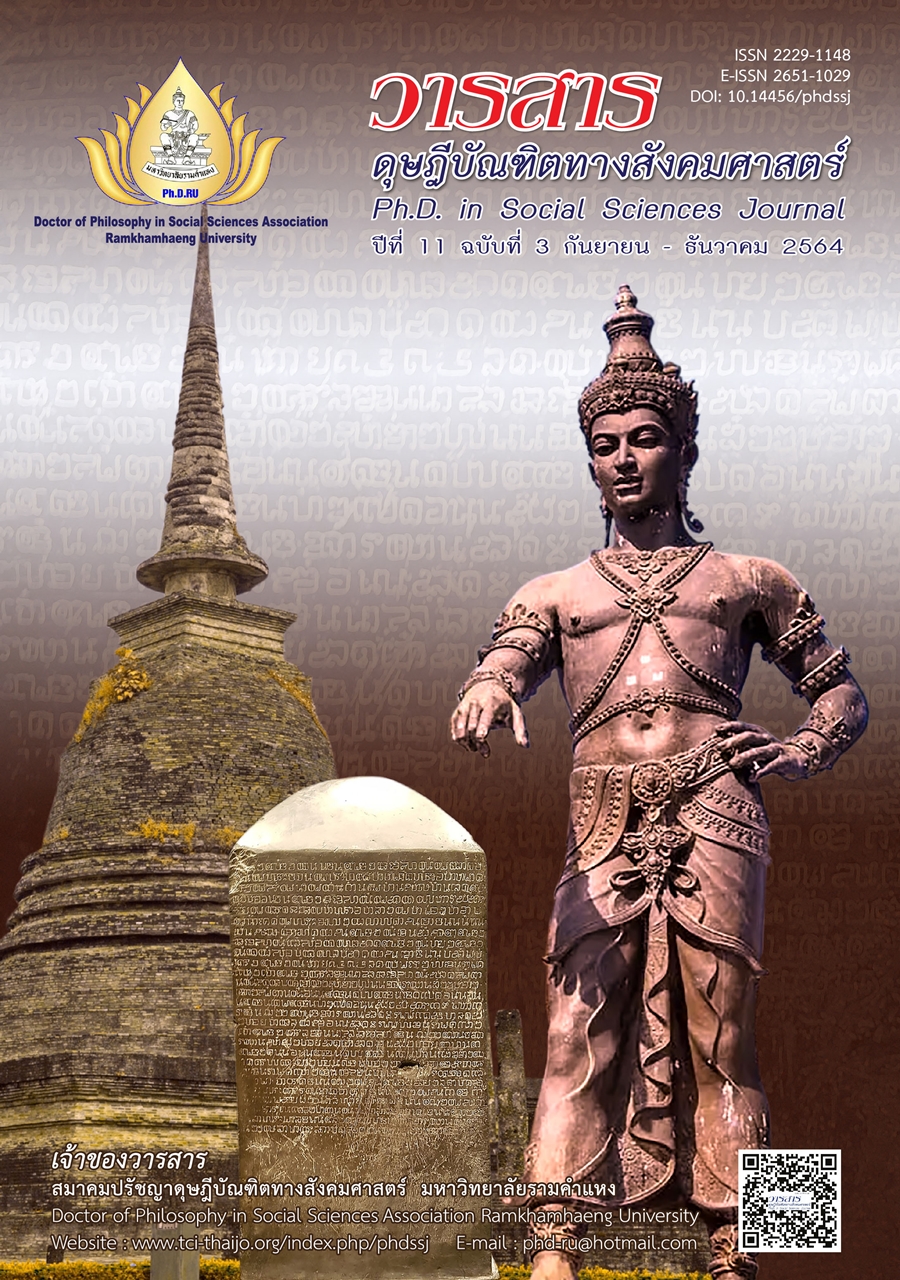Factors Influencing Organizational Commitment and Work Engagement of Employees in the Wood and Furniture Industry in Thailand
Main Article Content
Abstract
The objectives of this research are (1) to study the overall influences, direct and indirect influences of factors Influencing organizational commitment and work engagement of employees in the wood and furniture Industry in Thailand and (2) to verify the consistency of the causal model with the empirical data. The researcher used the quantitative research by distributing 322 questionnaire. The statistics used in data analysis were descriptive statistics and inferential statistics. In inferential statistics, the researcher employed the technique of structural equation modeling (SEM) with the LISREL program.
The results of the research showed that factors Influencing organizational commitment and work engagement of employees consisted of the followings: Career Advancement Opportunity was the most direct influence on organizational commitment influence, equal to 0.187, Organizational Commitment was direct influence on work engagement influence, equal to 0.518, the satisfaction with the supervisor was a direct influence on work engagement influence, equal to 0.369, statistically significant at 0.001 level. After software package processing was performed to test the consistency of the structural equation model, it was found that all indices indicated above passed the benchmark, namely, Chi-square/df = 1.736, SRMR = 0.048, CFI = 0.970, NFI = 0.934, TLI = 0.964, and RMSEA = 0.051. It can be concluded that the results of this analysis are consistent with the empirical data.
Article Details
Academic articles, research articles, and book reviews in the Ph.D. in Social Sciences Journal are author’s opinions, and not the publisher’s, and is not the responsibility of the Ph.D. in Social Sciences Journal Philosophy Association, Ramkhamhaeng University. (In the case that research is done on human, the researcher has to be trained in Ethics for Doing Research on Human Training and has to produce the evidence of the training).
References
Allen, N. J., & Meyer, J. P. (1990). The measurement and antecedents of affective, continuance, and normative commitment to the organization. The Journal of Occupational Psychology, 63(1), 1-18.
Andrew, J. D. (2001). Human relations: Interpersonal, job-oriented skills. Prentice Hall.
Bagozzi, R., & Yi, Y. (1988). On the evaluation of structural equation models. Journal of the Academy of Marketing Sciences, 16(1), 74-94.
Beyer, J. E., & Marshall, J. (1981). The interpersonal dimension of collegiality. Nursing Out Look, 29(11), 662-665.
Bonds, A. A. (2017). Employees’ organizational commitment and turnover intentions. Doctoral Dissertation of Business Administration, Walden University.
Burke. (2003). Employee engagement. Retrieved from http://www.burke.com
Burton, J. (2010). WHO healthy workplace framework and model: Background and supporting literature and practices. World Health Organization.
Clayton, A. P. (1972). Existence, relatedness, and growth: Human needs in organizational settings. Free Press.
Davis, K., & Newstrom, J. W. (1985). Human behavior at work: Organization behavior. McGraw-Hill.
Division of the Industrial Factory. (2018). List of companies in the wood and wood industry group house. Retrieved from https://userdb.diw.go.th/results1.asp [In Thai]
Field, A. (2005). Discovering statistics using SPSS (2nd ed.). Sage.
Gibson, J. L. (2000). Organizations: Behavior, structure, process (10th ed.). Irwin/McGraw-Hill.
Hair, J. F., Black, B., Babin, B. J., & Anderson, R. E. (2014). Multivariate data analysis (7th ed.). Pearson Education.
Hossein, N., & Robert, J. P. (2013). Career growth opportunities and employee turnover intentions in public accounting firms. British Accounting Review, 45(2), 138-148.
Hu, L., & Bentler, P. (1998). Fit indices in covariance structure modeling: Sensitivity to under parameterized model misspecification. Psychological Methods, 3(4), 424-453.
Hun, M. P. (2008). Univariate analysis and normality test using SAS, Stata, and SPSS. Retrieved from http://cef-cfr.ca/uploads/Reference/sasNORMALITY.pdf
Ismail, A., Mohamed, H. A., Sulaiman, A. Z., Mohamad, M. H., & Yusuf, M. H. (2011). An empirical study of the relationship between transformational leadership, empowerment and organizational commitment. Business and Economics Research Journal, 2(1), 89-107.
Jason, A. C., Jeffery, A. L., & Michael, J. W. (2009). Organizational behavior: Improving performance and commitment in the workplace. McGraw-Hill/Irwin.
Krejcie, R. V., & Morgan, D. W. (1970). Determining sample size for research activities. Educational and Psychological Measurement, 30(3), 607-610.
Luthans, F. (1995). Organizational behavior (7th ed.). McGraw-Hill.
Luthans, F. (2011). Organizational behavior: An evidence-based approach (12th ed.). McGraw-Hill/Irwin.
Maslow, A. H. (1954). Motivation and personality. Harper & Row.
Meyer, J. P., & Allen, N. J., & (1991). A three-component conceptualization of organizational commitment. Human Resource Management Review, 1(1), 61-89.
Miles, J., & Shevlin, M. (2001). Applying regression and correlation: A guide for students and researchers. Sage.
Nunnally, J. C. (1978). Psychometric theory (2nd ed.). McGraw-Hill.
Panel Plus Company Limited. (2017). MDF and particle board wood products. Retrieved from https://www.panelplus.co.th/product/detail/flame_retardant_board [In Thai]
Peter, C. (2012). Conflict management: A practical guide (4th ed.). TAFE.
Phillips, L. W. (1981). Assessing measurement error in key informant reports: A methodological note on organizational analysis in marketing. Journal of Marketing Research, 18(4), 395-415.
Porter, L. W., Steers, R. M., Mowday, R. T., & Boulian, P. V. (1974). Organization commitment, job satisfaction and turnover among psychiatric technicians. Journal of Applied Psychology, 59(5), 603-609.
Putnam, L. L., & Poole, M. S. (1992). Conflict and negotiation: Handbook of organizational communication (3rd ed.). Sage.
Schaufeli, W. B., & Bakker, A. B. (2004). Job demands, job resources and their relationship with burnout and engagement: A multi-sample study. Journal of Organizational Behavior, 25(3), 293-315.
Shalley, C. E., Gilson, L. L., & Blum, T. C. (2000). Matching creativity requirements and the work environment: Effects on satisfaction and intentions to leave. Academy of Management Journal, 43(2), 215-223.
Stevens, J. (1992). Applied multivariate statistics for the social sciences. Lawrence Erlbaum Associates.
Teerathanachaiyakun, K. (2014). Human resource management. Panyachon. [In Thai]
The Ken Blanchard Companies. (2019). Employee work passion - Volume 1: Employee passion. Retrieved from https://resources.kenblanchard.com/whitepapers/employee-workpassion-volume-1-employee-passion
Thompson, R. J. (2016). An investigation of work environment characteristics and work engagement of limited- and full-service hotel property front-line employees. Doctoral Dissertation of Philosophy, University of Southern Mississippi.


